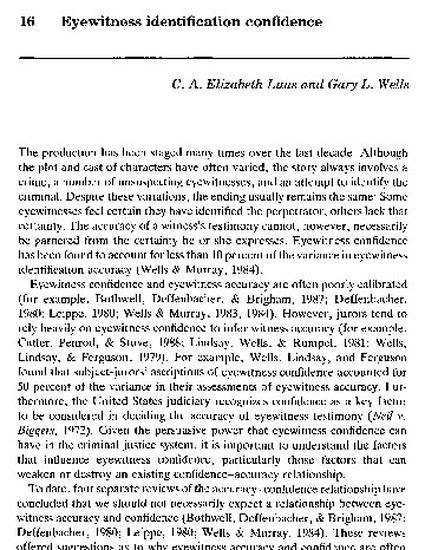
The production has been staged many times over the last decade. Although the plot and cast of characters have often varied, the story always involves a crime, a number of unsuspecting eyewitnesses, and an attempt to identify the criminal. Despite these variations, the ending usually remains the same: Some eyewitnesses feel certain they have identified the perpetrator; others lack that certainty. The accuracy of a witness's testimony cannot, however, necessarily be garnered from the certainty he or she expresses. Eyewitness confidence has been found to account for less than 10 percent of the variance in eyewitness identification accuracy (Wells & Murray, 1984).
Eyewitness confidence and eyewitness accuracy are often poorly calibrated (for example, Bothwell, Deffenbacher, & Brigham, 1987; Deffenbacher, 1980; Leippe, 1980; Wells & Murray, 1983, 1984). However, jurors tend to rely heavily on eyewitness confidence to infer witness accuracy (for example, Cutler, Penrod, & Stuve, 1988; Lindsay, Wells, & Rumpel, 1981; Wells, Lindsay, & Ferguson, 1979). For example, Wells, Lindsay, and Ferguson found that subject-jurors’ ascriptions of eyewitness confidence accounted for 50 percent of the variance in their assessments of eyewitness accuracy. Furthermore, the United States judiciary recognizes confidence as a key factor to be considered in deciding the accuracy of eyewitness testimony (Neil v. Biggers, 1972). Given the persuasive power that eyewitness confidence can have in the criminal justice system, it is important to understand the factors that influence eyewitness confidence, particularly those factors that can weaken or destroy an existing confidence-accuracy relationship.
Available at: http://works.bepress.com/gary_wells/5/

This is a chapter from Luus, C. A. E., & Wells, G. L. (1994). Eyewitness identification confidence. In D. F. Ross, J. D. Read, & M. P. Toglia (Eds.), Adult eyewitness testimony: Current trends and developments, pp. 348-361. New York: Cambridge University Press. doi: 10.1017/CBO9780511759192.017. Posted with permission.